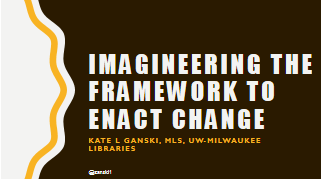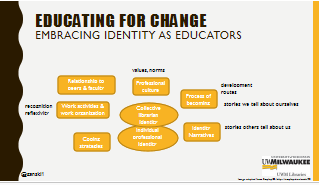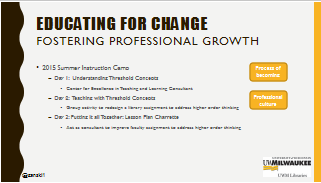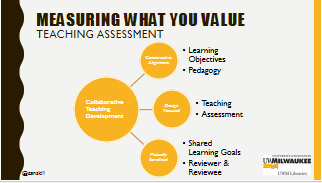Here is my portion of the ALA 2016 panel presentation Imagineering the Framework: Implementing and Assessing Information Literacy Programs. Many thanks to Tim Gritten and Olga Nesi for partnering on this great opportunity.

For my part of today’s talk I will address our first learning outcome: Provide leadership when strategizing with teachers, instructors, and other librarians to develop new practices to improve information literacy.
I am connecting leadership with change because this resonates with my personal leadership philosophy. Good leaders are able to give direction during times of change or enact change when the status quo is no longer sustainable.
So whether you or your team feels the Framework is causing the change (and thus you need to give direction) or you feel the Framework is an opportunity for change (and you want to enact it), I hope that you will be able to take away an actionable leadership idea from my talk today. And as I was challenged at the OCLC Symposium yesterday, I challenge you to take the first step within 72 hours of returning home.
Since I am an instruction librarian, let me start by giving you a road map for where we will be going and how we plan to get there.
- We have a limited amount of time together so it is necessary that I draw a few boundaries. I will do this by laying out what I hope to answer and what I assume you already know
- I am addressing you as leaders – managers, coordinators, directors – and thus I will focus on two paths or strategies that leverage your position or roles: educating for change through professional development and measuring what you value, aka assessment.
I hope to answer two questions: How can you lead your staff to embrace teaching with the Framework? And how could the Framework impact your contributions to student success? These are questions I’ve asked myself and attempted to answer for my library. I will share with you our approach and the theories behind it.
I am working with three assumptions: You want to lead your staff to embrace the Framework and therefore are familiar with it so I will not speak on the specifics of the Framework today. Second, some of your staff are reluctant to embrace it. And finally, you want to improve your libraries’ impact on campus student success goals.
I am not going to convince you that now is your time to lead. You are here because you want to enact change. At the same time, your staff may not be as excited about the possibility of change as you are.
Like me, you face increasing pressures to showcase the value of your instruction program, or make a case for hiring a new instruction librarian, or support an ask for additional space, or – you fill in the blank. We need to speak in meaningful ways about the value of our classroom contributions.
So let’s start with our staff. How can you lead your staff to embrace teaching with the Framework?

Embracing Identity as Educators
Here I am presenting a theoretical model for understanding professional identity. This is one model – there are others out there. This one illustrates complexity while also providing entry points for leadership impact. I also lean on the 2008 seminal article by Scott Walter, Librarians as teachers: A qualitative inquiry into professional identity. College & Research Libraries, 69(1), 51-71.
Walter and others such as Steve Bell and Jon Shank, have encouraged us to expand our vision of librarianship. When we expand our vision we are forced to evaluate our meaning and identity. Here I present to you a model representing a theory of professional identity. Let me highlight a few things. There are only a few inputs that we as leaders have control over in our day to day work environments. Other inputs are collectively owned by all of us and our professional associations. And then there are two inputs, Identity Narratives & Coping Strategies, that we have virtually no control over.
I am going to focus on the process of becoming. I want you to think about the following questions – what development routes are you providing for your instruction librarians? What stories do you tell when you talk about instruction in the library? I also will focus on our professional culture – what do you value in an instruction librarian? What do you hire for? What standards (implicit and explicit) do you hold? These standards become our norms and values.
In a 2015 article by Amanda N. Hess, Equipping academic librarians to integrate the framework into instructional practices: A theoretical application. The Journal of Academic Librarianship, 41(6), 771-776 (pay wall), Hess examines theories of adult learning to identify constructive approaches for educating library professionals on the Framework. Although her article was not written at the time we developed Summer Instruction Camp, we incorporate many of the practices she suggests.
About six years ago I was fairly new to my role as instruction coordinator. I took a look at what we were doing and saw that our training and professional development was suffering in one degree or another from unintentional learning opportunities, exclusive meetings, and unclear goals. We kept these concerns in mind when we were creating Summer Instruction Camp. Thus our program is designed to be intentional. Librarians love to learn and most explore routes on their own. The challenge is sharing new insights and energy with peers in a way that leads to meaningful growth. We also are inclusive. We don’t want to favor the “star” instructors or new staff or a particular department. We recognize that librarians in many departments or units teach and all of us of the capacity and desire to improve our instruction. Finally we are strategic with the theme and content of camp. This gives us the opportunity to address specific developmental needs or shape the direction of the information literacy program or in the this particular example, educate on developments in our profession (Framework and threshold concepts.)

Fostering Professional Growth
2015 Summer Instruction Camp was focused on working with the Framework. Our goal was to create a community of practice to improve instruction. We design each camp on the principles that it be fun, authentic, and a reflective experience. To encourage application not just acquiring new information, we use a three part format – lesson, group application, individual application. Camp provides an opportunity for collective visioning and adoption of new practices. Over the course of three workshops, staff were able to learn from an expert outside of the library, practice working with the Framework with their peers and trusted colleagues, and develop an improved library instruction integration for work that is meaningful to them. Thus we incorporated strategies that work for adult learners: staff were enticed to learn, not forced; it was rewarding to be a camper! Understanding and working with the Framework was not left solely to the individual. Individually and collectively we developed a path forward with guidance from experts and peers.
Let’s shift and look at ways to address professional culture. The model for professional identity highlights Relationship to peers and faculty and work activities and organizations as influences on one’s identity. As a leader, you can help empower your instructional staff by giving them a seat at the proverbial table where curriculum or assessment conversations are happening. Here are three practical ways you could do this. 1. What included in the position description for your instructional staff? Are their campus roles clear? Does the position description center on instruction or is that an add on following collection development or research assistance? Is instruction the focus for only 1-2 librarians in your library? 2. Can you use your influence to place instructional staff at curriculum planning discussions? 3. Are you engaging your educational centers to put librarians in contact with faculty? Or what other ways could you encourage partnerships with campus units to improve student learning?
Those are a few of the approaches I use to lead instructional staff. I will now turn to address my second question, how could the Framework impact your contributions to student success?
“If you want to change what you care about, change what you measure.” Dan Ariely
What do you value in your instruction program? Are your measurements aligned with what you value? I imagine most of us our measuring number of classes taught and number students in attendance. What are we saying we value by reporting this?
Some of us are measuring student performance – pre & post tests, online tutorials, bibliography submission. Are you measuring the behavior you want or does what you measure encourage something less meaningful? Are you focusing on short term post-class assessments or are you collaborating with faculty to assess information literacy critical thinking? I think the short-term measurements focus more on what a librarian is able to accomplish in 50 or 75 minutes, e.g. teach a student how to click through a database to find a scholarly article, instead of measuring student understanding of why and how working with scholarly articles impacts their knowledge and critical thinking.

Authentic Assessment
In this modified model of threshold concepts and knowledge content, educators can privilege critical reflection over doing; mind mapping over “correct answers” and behavior awareness over check boxes. The standards invite us to measure performance outcomes, e.g. demonstrate ability to find scholarly articles, the Framework invites us to let go of the mirage of a 50 minute summative assessment and imagine a student’s information literacy development from novice to expert. There is greater potential to scaffold information literacy in the path towards graduation. Our imagination is expanded to envision how a capstone student thinks, researchers, writes compared with the incoming freshman. By embracing the Framework we can position ourselves as partners in graduation efforts not just a “service” for faculty.
What does this shift in measuring value? It rewards integration and strategic outreach- a proactive model – over the one-shot reactive sessions.
That was an example of re-thinking assessment in a course collaboration, now let’s re-think programmatic assessment. I am providing an example way to measure course integration through a degree program by mapping out our partners and learning outcomes. This particular example is aligned with the AACU VALUE rubric because I work at an institution that was an early partner in the LEAP initiative. You could imagine how this might be charted more closely to the Framework or your local accreditation standards. In this example the shift from standards to Framework seems subtle, but that is deceptive. The emphasis is not on librarians doing something or accomplishing it all in a single session, but on students progressively learning. It empowers staff to have a vision beyond the one-shot which is what the Framework invites us to do. What does this approach value? It rewards curriculum alignment and faculty collaboration. It does not award number of classes taught. It is strategic.

Programmatic Assessment
How might you use this? Librarians could map out their subjects and departments to identify where information literacy is crucial to student success. It could be used to inform annual evaluations of library efforts or in program reviews with faculty. It could be used to help set goals for information literacy programs or as a reporting tool for accreditation.
Finally the Framework could be leveraged to change the way you assess teaching. Instead of assessing teaching based on short-term student assessments or number of sessions taught, you could use a Collaborative teaching development model to shift the focus away from content to design. This model values learning and developing while de-emphasizing expertise and style. It is a mutually beneficial model where all review participants have the opportunity to learn and grow. The focus is not just on the one under review, but on all participants. It aligns with the goal of developing teacher librarians. It rewards professional growth and the librarian as teacher.

I am intrigued by your presentation. . . I see so many possibilities for partnering with academic departments at my college. I would love to know more. What would librarians as partners in completion look like? Is this something a small library staff could successfully undertake? I could see us collaborating with one of our degree programs on one of our annual student learning outcomes. Please continue publishing your experiences and research!
LikeLike
Thanks for your comment and questions, Christy. Yes, I think a small library staff could undertake a partnership with a department/degree program to partner for information literacy success. At a minimal level I could envision a librarian advising faculty on how to integrate and assess IL up through the major.
LikeLike